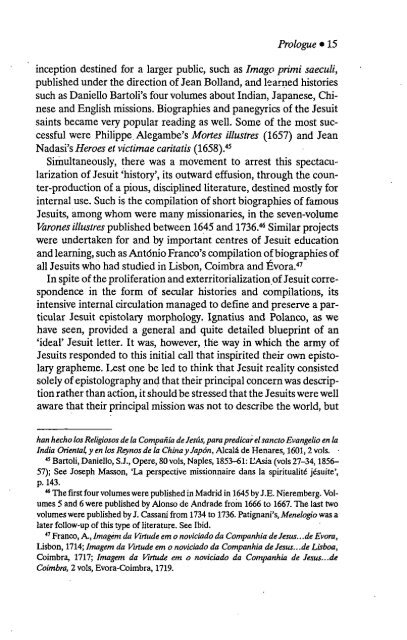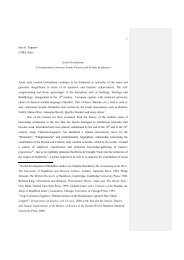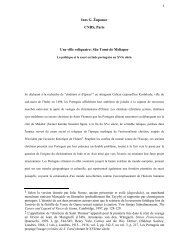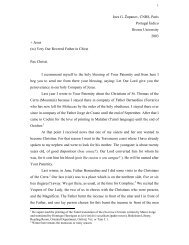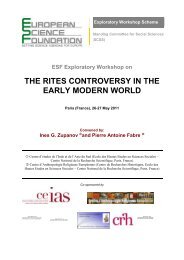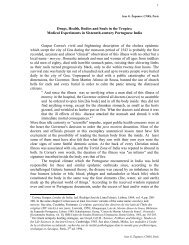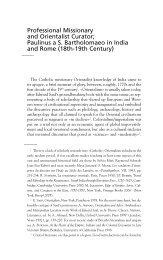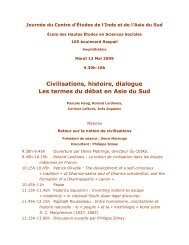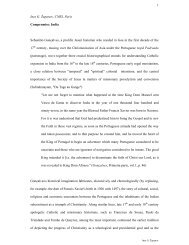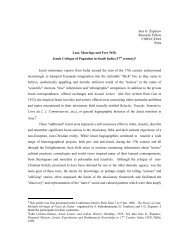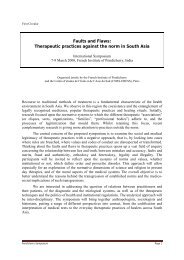INES G. ZUPANOV - Ines G. Županov
INES G. ZUPANOV - Ines G. Županov
INES G. ZUPANOV - Ines G. Županov
Create successful ePaper yourself
Turn your PDF publications into a flip-book with our unique Google optimized e-Paper software.
Prologue • 15<br />
inception destined for a larger public, such as Imago primi saeculi,<br />
published under the direction of Jean Bolland, and learned histories<br />
such as Daniello Bartoli's four volumes about Indian, Japanese, Chinese<br />
and English missions. Biographies and panegyrics of the Jesuit<br />
saints became very popular reading as well. Some of the most successful<br />
were Philippe. Alegambe's Mortes illustres (1657) and Jean<br />
Nadasi's Heroes et victimae caritatis (1658). 45<br />
Simultaneously, there was a movement to arrest this spectacularization<br />
of Jesuit 'history', its outward effusion, through the counter-production<br />
of a pious, disciplined literature, destined mostly for<br />
internal use. Such is the compilation of short biographies of famous<br />
Jesuits, among whom were many missionaries, in the seven-volume<br />
Varones illustres published between 1645 and 1736. 46 Similar projects<br />
were undertaken for and by important centres of Jesuit education<br />
and learning, such as Antonio Franco's compilation of biographies of<br />
all Jesuits who had studied in Lisbon, Coimbra and Évora. 47<br />
In spite of the proliferation and exterritorialization of Jesuit correspondence<br />
in the form of secular histories and compilations, its<br />
intensive internal circulation managed to define and preserve a particular<br />
Jesuit epistolary morphology. Ignatius and Polanco, as we<br />
have seen, provided a general and quite detailed blueprint of an<br />
'ideal' Jesuit letter. It was, however, the way in which the army of<br />
Jesuits responded to this initial call that inspirited their own epistolary<br />
grapheme. Lest one be led to think that Jesuit reality consisted<br />
solely of epistolography and that their principal concern was description<br />
rather than action, it should be stressed that the Jesuits were well<br />
aware that their principal mission was not to describe the world, but<br />
han hecho los Religiosos de la Compañía de Jesús, para predicar el sancto Evangelio en la<br />
India Oriental, y en los Reynos de la China y Japón, Alcalá de Henares, 1601,2 vols. •<br />
45 Bartoli, Daniello, S.J., Opere, 80 vols, Naples, 1853-61: L'Asia (vols 27-34,1856-<br />
57); See Joseph Masson, 'La perspective missionnaire dans la spiritualité jésuite',<br />
p. 143.<br />
46 The first four volumes were published in Madrid in 1645 by J.E. Nieremberg. Volumes<br />
5 and 6 were published by Alonso de Andrade from 1666 to 1667. The last two<br />
volumes were published by J. Cassani from 1734 to 1736. Patignani's, Menelogio was a<br />
later follow-up of this type of literature. See Ibid.<br />
47 Franco, A., Imagem da Virtude em o noviciado da Companhia de Jesus. ..de Evora,<br />
Lisbon, l'i'14; Imagem da Virtude em o noviciado da Companhia de Jesus...de Lisboa,<br />
Coimbra, 1717; Imagem da Virtude em o noviciado da Companhia de Jesus...de<br />
Coimbra, 2 vols, Evora-Coimbra, 1719.


